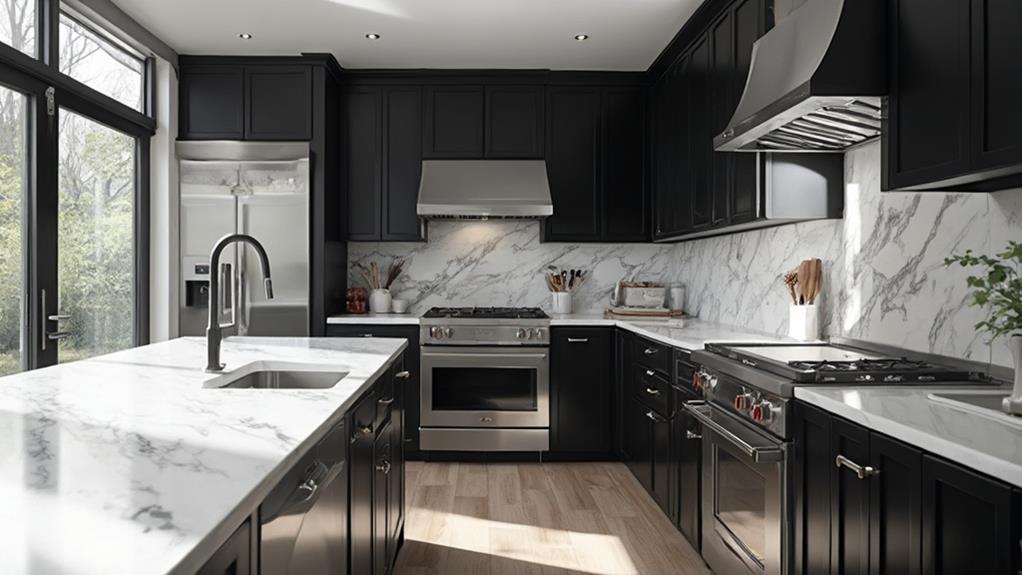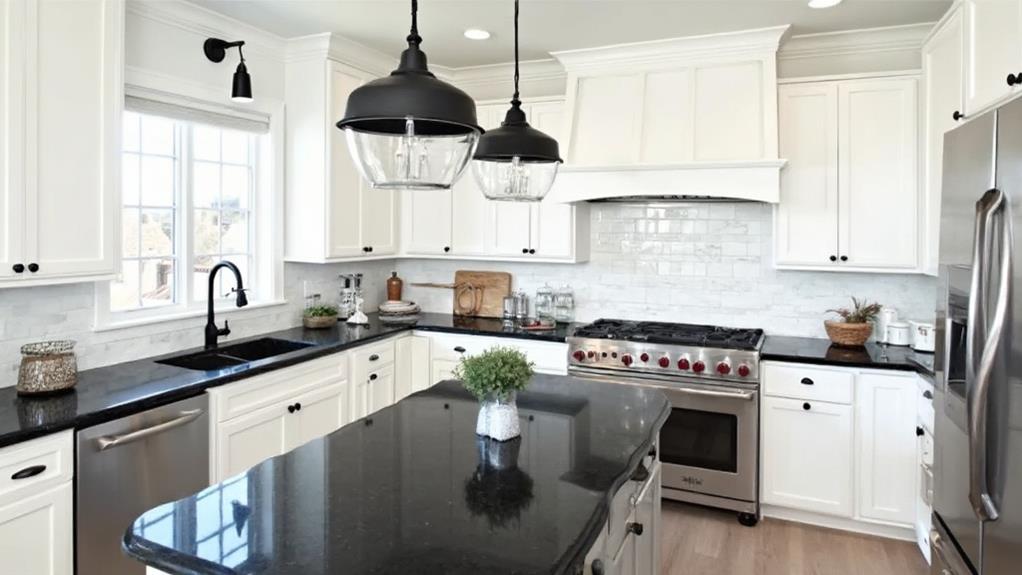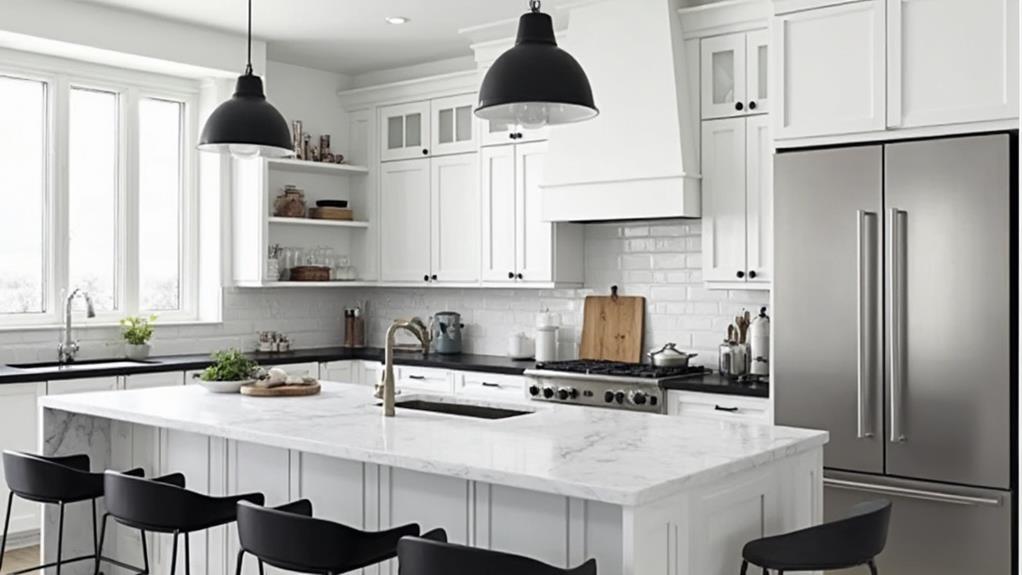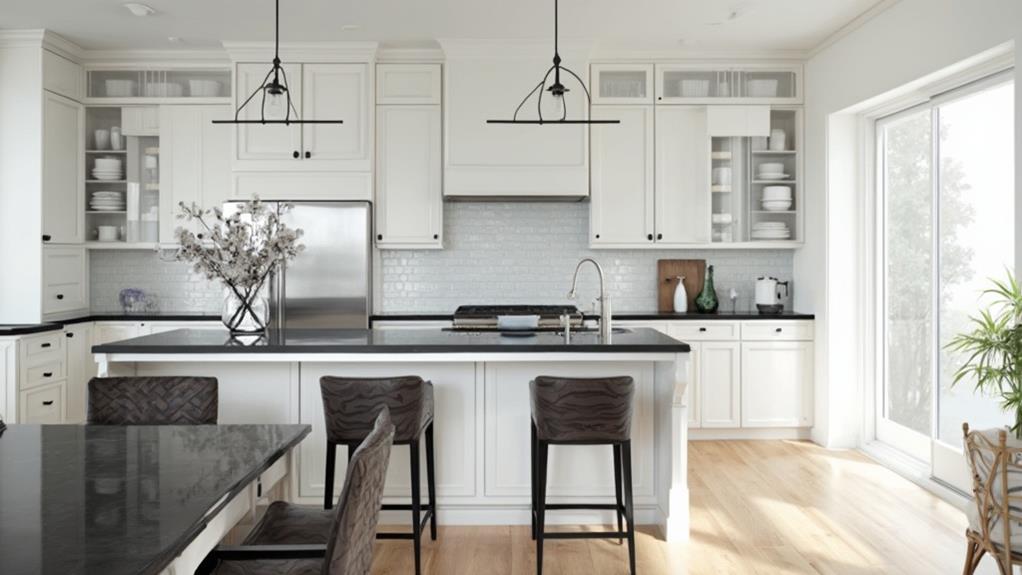To create a timeless black and white kitchen, start by choosing the right shades and balancing them in a 70/30 or 60/40 ratio. Select contrasting materials like white marble countertops with black cabinets or vice versa. Mix matte and glossy finishes to add depth and interest. Incorporate stainless steel appliances as a neutral bridge. Layer your lighting with ambient, task, and accent options to enhance the space. Accessorize with metallic accents, natural elements, and pops of color through statement pieces. By carefully considering each element, you'll achieve a sophisticated, enduring look that'll stand the test of time. Discover more tips to perfect your monochrome masterpiece.
Choosing the Right Shades

When it comes to choosing the right shades for your black and white kitchen, it's crucial to strike a balance between contrast and harmony. Start by selecting a dominant color, either black or white, and use the other as an accent. For a brighter, more open feel, opt for a primarily white kitchen with black accents. Conversely, a predominantly black kitchen with white highlights creates a bold, dramatic look.
Consider the undertones in your chosen shades. Warm whites with yellow or red undertones can soften the space, while cool whites with blue or green undertones create a crisp, modern aesthetic. For black, choose between rich, deep blacks or softer charcoal hues.
Don't forget about texture and finish. Matte surfaces absorb light and create a softer look, while glossy finishes reflect light and add depth. Mix and match finishes to create visual interest and prevent the space from feeling flat.
Balancing Black and White
The art of balancing black and white in your kitchen design is crucial for achieving a harmonious and visually striking space. To create a timeless look, you'll need to carefully consider the proportions of each color. A good rule of thumb is to use one color as the dominant shade and the other as an accent.
If you've chosen white as your primary color, use black sparingly to add depth and contrast. Incorporate black in smaller elements like cabinet hardware, light fixtures, or a statement appliance. Conversely, if you've opted for a predominantly black kitchen, use white to brighten the space and prevent it from feeling too dark or cramped.
Consider using a 70/30 or 60/40 ratio between your dominant and accent colors. This creates visual interest without overwhelming the senses. You can also introduce gray tones as a neutral bridge between black and white, softening the contrast and adding depth to your design.
Don't forget to play with textures and materials to enhance the balance. Mix matte and glossy finishes, or combine smooth surfaces with textured ones to add dimension to your black and white palette.
Material Selection for Contrast

Selecting the right materials is key to amplifying the contrast in your black and white kitchen. Focus on choosing materials that enhance the visual impact of your color scheme while maintaining a timeless appeal. For countertops, consider white marble or quartz with subtle veining to add depth and interest. Pair these with matte black granite or soapstone for a striking contrast.
For cabinetry, opt for high-quality painted wood or sleek lacquered finishes. White Shaker-style cabinets offer a classic look, while glossy black upper cabinets can create a dramatic effect. Incorporate stainless steel appliances to bridge the gap between black and white elements.
When it comes to backsplashes, consider white subway tiles with dark grout for a crisp, clean look. Alternatively, use black hexagonal tiles with white grout for a more modern approach. For flooring, large-format black tiles or dark hardwood can ground the space, while white porcelain tiles can brighten it.
Don't forget about hardware and fixtures. Matte black faucets, drawer pulls, and light fixtures can add sophistication, while chrome or brushed nickel options provide a softer contrast against both black and white surfaces.
Lighting in Monochrome Kitchens
Illumination plays a crucial role in creating the perfect ambiance for your monochrome kitchen. When working with a black and white palette, lighting becomes even more important to highlight contrast and add depth to your space.
Consider layering different types of lighting to achieve a balanced look. Start with ambient lighting, such as recessed ceiling lights or pendant fixtures, to provide overall illumination. Then, add task lighting under cabinets or above work areas to ensure proper visibility for food preparation and cooking.
Accent lighting can help showcase specific features of your monochrome kitchen. Use spotlights to draw attention to artwork or architectural elements, or install strip lights along the toe kicks of your cabinets for a subtle glow.
Don't forget about natural light! Maximize windows and skylights to bring in daylight, which can enhance the crisp contrast between black and white surfaces. If privacy is a concern, opt for sheer window treatments that allow light to filter through.
Choose light fixtures that complement your kitchen's style. Sleek, modern designs in chrome or brushed nickel can enhance a contemporary look, while vintage-inspired fixtures in matte black can add character to a more traditional space.
Accessorizing Your Two-Tone Space

Accessories are the finishing touches that bring your black and white kitchen to life. When selecting items for your two-tone space, focus on pieces that complement the monochromatic theme while adding visual interest. Consider incorporating metallic accents like brass or chrome hardware, faucets, and light fixtures to add warmth and sophistication.
Choose display items carefully, opting for a mix of black, white, and neutral-toned pieces. Glass canisters filled with dry goods, ceramic vases, and sleek appliances can serve as both functional and decorative elements. Don't forget to add natural elements to soften the stark contrast. A bowl of fresh fruit, potted herbs, or a vase of flowers can inject life and color into your kitchen.
Textiles offer another opportunity to enhance your black and white scheme. Select dish towels, pot holders, and seat cushions in complementary patterns or textures. Geometric designs or subtle stripes can add depth without overwhelming the space. Finally, consider introducing a pop of color through a single statement piece, like a vibrant piece of artwork or a boldly colored small appliance, to create a focal point in your timeless monochrome kitchen.
Conclusion
You've now got all the tools to create your timeless black and white kitchen. Remember, it's all about balance and contrast. Don't be afraid to mix textures and materials to add depth. With the right lighting and carefully chosen accessories, you'll have a space that's both classic and modern. So go ahead, unleash your inner designer, and create a kitchen that'll stand the test of time. It'll be the bee's knees for years to come!

